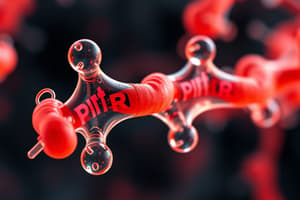Podcast
Questions and Answers
What effect does a positive reward-prediction error (RPE) have on cue-reward associations?
What effect does a positive reward-prediction error (RPE) have on cue-reward associations?
- It strengthens cue-reward associations. (correct)
- It eliminates the need for rewards.
- It weakens cue-reward associations.
- It has no effect on cue-reward associations.
In the context of reinforcement learning, what happens when a reward is unexpectedly omitted?
In the context of reinforcement learning, what happens when a reward is unexpectedly omitted?
- A positive prediction error is generated.
- A negative prediction error is produced. (correct)
- Dopamine activity increases.
- There is a significant increase in anticipatory responses.
Which visual stimuli elicited anticipatory licking in the test phase?
Which visual stimuli elicited anticipatory licking in the test phase?
- A and B
- A and AX (correct)
- B and Y
- Only A
How does blocking relate to learning in reinforcement learning?
How does blocking relate to learning in reinforcement learning?
What effect does a downshift in reward salience have in the extinction process?
What effect does a downshift in reward salience have in the extinction process?
Which method was employed to artificially mimic a reward-prediction error in the described study?
Which method was employed to artificially mimic a reward-prediction error in the described study?
In the results section, what was observed with dopamine responses to stimulus B?
In the results section, what was observed with dopamine responses to stimulus B?
What is the primary finding regarding the effects of microinjections of naloxone into the vlPAG during extinction training?
What is the primary finding regarding the effects of microinjections of naloxone into the vlPAG during extinction training?
How does the dose of naloxone affect the freezing response in rats during extinction training, according to experiment #4?
How does the dose of naloxone affect the freezing response in rats during extinction training, according to experiment #4?
Which experimental method was used to assess the impact of naloxone on the extinction of conditioned fear?
Which experimental method was used to assess the impact of naloxone on the extinction of conditioned fear?
What was the outcome when naloxone was microinjected into the dPAG during fear conditioning?
What was the outcome when naloxone was microinjected into the dPAG during fear conditioning?
What hypothesis is suggested regarding the role of ITC neurons in fear extinction processes?
What hypothesis is suggested regarding the role of ITC neurons in fear extinction processes?
What does reduced firing of dopamine neurons in the VTA during a downshift in reward indicate?
What does reduced firing of dopamine neurons in the VTA during a downshift in reward indicate?
How do optogenetic manipulations of dopamine neurons affect extinction learning?
How do optogenetic manipulations of dopamine neurons affect extinction learning?
What type of prediction error enhances the learning of an association during a non-rewarded trial?
What type of prediction error enhances the learning of an association during a non-rewarded trial?
What role do phasic dopamine signals play in the learning process?
What role do phasic dopamine signals play in the learning process?
What happens to animals with inhibited dopamine neurons during both positive and negative reward prediction errors?
What happens to animals with inhibited dopamine neurons during both positive and negative reward prediction errors?
What outcome is observed when rats undergo extinction via nonreinforced presentations of the conditioned stimulus?
What outcome is observed when rats undergo extinction via nonreinforced presentations of the conditioned stimulus?
What is the effect of naloxone injections in the vlPAG on fear extinction?
What is the effect of naloxone injections in the vlPAG on fear extinction?
What was the primary goal of the first experiment regarding opioid receptors in the vlPAG?
What was the primary goal of the first experiment regarding opioid receptors in the vlPAG?
What variable parameter was adjusted in the second experiment involving CS exposures during extinction?
What variable parameter was adjusted in the second experiment involving CS exposures during extinction?
What is the primary focus of the role of opioid receptors in fear extinction according to the experiments conducted?
What is the primary focus of the role of opioid receptors in fear extinction according to the experiments conducted?
What happens to dopamine activity when a reward is unexpectedly omitted?
What happens to dopamine activity when a reward is unexpectedly omitted?
Anticipatory licking was observed for stimulus B.
Anticipatory licking was observed for stimulus B.
What is the formula for calculating reward-prediction error (RPE)?
What is the formula for calculating reward-prediction error (RPE)?
A positive reward-prediction error strengthens cue-reward associations through the presentation of a(n) __________ reward.
A positive reward-prediction error strengthens cue-reward associations through the presentation of a(n) __________ reward.
Match the following terms with their definitions:
Match the following terms with their definitions:
During which phase did anticipatory licking occur for stimulus A?
During which phase did anticipatory licking occur for stimulus A?
Dopamine neurons become more active when a reward is expected and presented.
Dopamine neurons become more active when a reward is expected and presented.
What is the main role of dopamine activity in the learning process?
What is the main role of dopamine activity in the learning process?
What type of prediction error is critical for extinction learning?
What type of prediction error is critical for extinction learning?
Optogenetic activation of dopamine neurons during a non-rewarded trial enhances the extinction of learned behaviors.
Optogenetic activation of dopamine neurons during a non-rewarded trial enhances the extinction of learned behaviors.
What is the effect of opioid receptor manipulation in the vlPAG on fear extinction?
What is the effect of opioid receptor manipulation in the vlPAG on fear extinction?
Dopamine neuron activity during unexpected __________ omission was necessary for adjusting behavior in response to reduced rewards.
Dopamine neuron activity during unexpected __________ omission was necessary for adjusting behavior in response to reduced rewards.
Match the type of prediction error with its effect on learning:
Match the type of prediction error with its effect on learning:
Which result was observed when dopamine neurons were inhibited during reward prediction errors?
Which result was observed when dopamine neurons were inhibited during reward prediction errors?
Animals with optogenetic stimulation during a downshift in reward experience enhanced extinction learning.
Animals with optogenetic stimulation during a downshift in reward experience enhanced extinction learning.
What were the rats subjected to in the fear acquisition experiment?
What were the rats subjected to in the fear acquisition experiment?
What is the primary finding regarding the Hippocampus and Perirhinal Cortex in perceptual learning?
What is the primary finding regarding the Hippocampus and Perirhinal Cortex in perceptual learning?
Participants with bilateral MTL damage show no disruption in discriminating pre-exposed from non-exposed faces.
Participants with bilateral MTL damage show no disruption in discriminating pre-exposed from non-exposed faces.
What regions of the brain are investigated in terms of visual information encoding?
What regions of the brain are investigated in terms of visual information encoding?
The functional region of interest for face encoding is known as the ______.
The functional region of interest for face encoding is known as the ______.
In Experiment 2A, what was noted about discrimination accuracy between stimulus types?
In Experiment 2A, what was noted about discrimination accuracy between stimulus types?
Match the following Hippocampus regions with their functions:
Match the following Hippocampus regions with their functions:
What was the control group's performance trend across the blocks in terms of discrimination?
What was the control group's performance trend across the blocks in terms of discrimination?
Greater BOLD activity was observed for non-exposed face pairs in the FFA region.
Greater BOLD activity was observed for non-exposed face pairs in the FFA region.
What was the primary outcome of microinjections of naloxone into the vlPAG during extinction training?
What was the primary outcome of microinjections of naloxone into the vlPAG during extinction training?
Microinjections of naloxone into the dPAG impair the extinction of conditioned fear.
Microinjections of naloxone into the dPAG impair the extinction of conditioned fear.
During which phase did naloxone animals show significantly more freezing than saline animals?
During which phase did naloxone animals show significantly more freezing than saline animals?
The effects of naloxone on fear extinction were __________, indicating a relationship between dose and freezing response.
The effects of naloxone on fear extinction were __________, indicating a relationship between dose and freezing response.
Match the experiments with their findings:
Match the experiments with their findings:
What effect does a higher dose of naloxone have on freezing during a drug-free test?
What effect does a higher dose of naloxone have on freezing during a drug-free test?
Disruption of the ITC neurons is hypothesized to promote fear extinction.
Disruption of the ITC neurons is hypothesized to promote fear extinction.
Which areas of the brain are involved in fear expression and inhibition?
Which areas of the brain are involved in fear expression and inhibition?
Flashcards are hidden until you start studying
Study Notes
### Dopamine Signals and Reward Prediction Errors
- Dopamine signals are consistent with reward prediction errors in temporal difference reinforcement learning.
- Dopamine activity increases during unexpected rewards (positive prediction error), decreases during omitted rewards (negative prediction error), and remains unchanged during expected rewards (no prediction error).
- Monkey study: Monkeys were trained to associate visual stimuli (A, B, X, Y) with rewards.
- Phase 1: A reliably predicted reward.
- Phase 2: B never predicted reward.
- Phase 3: AX combination predicted reward (learning about compound cues).
- Phase 4: BY combination predicted reward.
- Dopamine activity in the study:
- Increased in response to A and AX but not to X because it was not directly paired with reward.
- Increased in response to BY and Y because they were paired with reward.
- Decrease in response to A when the expected reward was omitted.
- Optogenetics: Artificial manipulation of dopamine neurons to mimic reward prediction errors.
- Optogenetic inhibition: Blocking of dopamine neurons during downshift extinction (less reward than expected) impaired extinction learning.
- Optogenetic activation: Mimicking a positive prediction error during non-rewarded trials enhanced learning of an association with reward.
- Conclusion: Dopamine signals are causally linked to learning, with changes in their activity affecting learning from changes in reward expectations.
Opioid Receptors and Fear Extinction
- Hypothesis: Opioid receptor antagonism in the periaqueductal gray (PAG) impairs fear extinction.
- Methods: Rats were trained to associate an auditory stimulus (CS) with a foot shock (US), leading to fear conditioning.
- Fear extinction: Extinction training involved repeated presentations of the CS without the US, aiming to reduce the freezing response.
- Naloxone: An opioid receptor antagonist, its effects were tested on different PAG subregions.
- Experiment #1: Microinjections of naloxone into the ventrolateral PAG (vlPAG) impaired fear extinction during the initial phase but did not reinstate the extinguished fear response.
- Experiment #2: Naloxone in the vlPAG also impaired extinction, confirming the reliability of the impairment and demonstrating its effect on a drug-free test.
- Experiment #3: Naloxone microinjections into the dorsolateral PAG (dlPAG) did not impair fear extinction.
- Experiment #4: Naloxone's effect on fear extinction was dose-dependent, with higher doses leading to greater freezing during testing.
- Conclusion: Opioid receptors in the vlPAG are crucial for fear extinction. Disrupting them impairs the ability to extinguish conditioned fear responses.
Interconnected Brain Regions and Fear Extinction
- Fear conditioning: The amygdala (BLA) plays a critical role in fear conditioning, with projections to the central amygdala (CeA) leading to fear expression.
- Fear extinction: The infralimbic cortex (ITC) inhibits fear expression by projecting to the CeA.
- ITC disruption: Disrupting ITC neurons is hypothesized to impair fear extinction, leading to the persistence of fear responses after extinction training.
Mundy et al. Study
- Hypothesis: Hippocampus and Perirhinal Cortex contribute to distinct types of perceptual learning.
- Hippocampus plays a selective role in scene learning.
- Perirhinal Cortex plays a dominant role in face learning.
- Participants:
- Two patients with brain damage (HC3, MTL3).
- 16 healthy participants.
- Methods:
- Combined causal (lesioned patients) and correlational (fMRI) approaches to study MTL's role in visual information encoding.
- fMRI with BOLD signal measured brain activity.
- Focused on regions of interest (fROI):
- FFA: Face encoding region.
- PPA: Scene encoding region.
- MTL regions: Perirhinal Cortex (PrC), Anterior Hippocampus (AntHC), Posterior Hippocampus (PostHC).
- Results:
- Experiment 1 (Lesion Study):
- Discrimination:
- Control participants showed equal differentiation between pre-exposed and non-exposed stimuli.
- HC3 exhibited difficulty differentiating pre-exposed and non-exposed scenes.
- MTL3 displayed impairment in differentiating both pre-exposed faces and scenes.
- Reaction Time (RT):
- Control participants showed no RT differences between pre-exposed and non-exposed stimuli.
- HC3 took longer to respond to scene stimuli.
- MTL3 took longer to respond to face and scene stimuli.
- Learning:
- Control participants showed learning across blocks for all stimulus types.
- HC3 showed learning for dots and faces but not scenes.
- MTL3 showed learning for dots but not faces or scenes.
- Discrimination:
- Experiment 2 (fMRI Study):
- 2A (Exposure History):
- No significant differences in discrimination accuracy between stimulus types.
- Participants performed better in discriminating pre-exposed stimuli compared to non-exposed stimuli.
- 2B (Discrimination Accuracy):
- FFA exhibited higher activity for pre-exposed face pairs compared to non-exposed face pairs.
- PPA showed higher activity for pre-exposed scene pairs compared to non-exposed scene pairs.
- No modulation observed for dots.
- PrC showed association with discrimination accuracy for faces but not scenes.
- PostHC showed association with discrimination accuracy for scenes but not faces.
- AntHC exhibited no association with discrimination accuracy for either faces or scenes.
- 2A (Exposure History):
- Experiment 1 (Lesion Study):
Waelti et al. Study
- Hypothesis: Dopamine signals are not always consistent with reward prediction errors.
- Emphasizes the prediction error signal in temporal difference reinforcement learning.
- Participants: Monkeys.
- Methods:
- Four visual stimuli (A, B, X, Y) presented during four phases.
- Phase 1: A + juice (A > CR)
- Phase 2: B + no juice (B)
- Phase 3: AX + juice (A+X > CR)
- Phase 4: BY + juice (Y > CR)
- Four visual stimuli (A, B, X, Y) presented during four phases.
- Results:
- Anticipatory Licking:
- Present for A and AX but absent for X during the test phase.
- No anticipatory licking observed for B.
- Anticipatory licking for BY (since it was paired with juice).
- Anticipatory licking for Y during the test phase.
- Dopamine Activity:
- Phase 1 & 2:
- A: Dopamine response to CS, dopamine dip when reward not presented.
- B: No response to CS, dopamine activity to unexpected reward.
- Compound Phases:
- AX: Dopamine response to A+X.
- BY: Increasing dopamine response to B+Y.
- Test Phase:
- X: Response to CS (but less than Y), no change in response when not presented.
- Y: Increased response to CS, dopamine dip when not presented.
- Phase 1 & 2:
- Reward Prediction Errors:
- Unexpected rewards: Prediction error signal; increase in dopamine activity.
- Omitted reward: Negative prediction error; decrease in dopamine activity.
- Expected reward: No prediction error; no change in dopamine activity.
- Anticipatory Licking:
Steinberg et al. Study
- Hypothesis: Dopamine activity functions as a teaching signal, influencing learning about antecedent cues.
- Focuses on the role of reward prediction errors (RPE) in learning.
- Methods:
- Used optogenetics to artificially mimic RPE by stimulating dopamine neurons.
- Conducted behavioral experiments focusing on blocking and extinction tasks.
- Results:
- Downshift Extinction Task:
- Dopamine neurons exhibited reduced firing in response to a downshift in reward, indicating a negative prediction error.
- Optogenetic inhibition of dopamine neurons during downshift impaired extinction of learned behavior.
- Non-rewarded Trial:
- Optogenetic activation of dopamine neurons during non-rewarded trials enhanced learning of a stimulus-reward association.
- Phasic Dopamine Signals:
- Phasic dopamine signals directly influence learning, with manipulation (inhibition or activation) affecting the ability to learn from reward expectation changes.
- Unexpected Reward Omission:
- Dopamine neuron activity during unexpected reward omission was crucial for behavioral adjustments in response to reduced rewards.
- Dopamine Neuron Inhibition:
- Animals with inhibited dopamine neurons during reward prediction errors (positive and negative) showed learning deficits in response to changing reward contingences.
- Downshift Extinction Task:
McNally et al. Study
- Hypothesis: Opioid receptors within the Periaqueductal Gray (PAG) play a crucial role in fear extinction, specifically through conditioned freezing behavior.
- Methods:
- Fear Acquisition: Rats were conditioned to associate an auditory CS with a foot shock US (tone + footshock = freezing).
- Fear Extinction: Extinction involved repeatedly presenting the CS without the US (tone + no footshock = decreased freezing).
- Experiments:
- Experiment 1: Focused on the role of vlPAG opioid receptors in acquisition and expression of fear extinction, using microinjections of the opioid receptor antagonist naloxone.
- Experiment 2: Further examined the role of vlPAG opioid receptors in extinction, using different CS exposure parameters and a drug-free test.
- Experiment 3: Investigated the role of dPAG opioid receptors in extinction, using the same methodology as Experiment 1.
- Experiment 4: Examined the dose-response relationship between naloxone and fear extinction in vlPAG.
- Results:
- Experiment 1:
- Naloxone microinjections into vlPAG impaired fear extinction but did not reinstate fear responses.
- Naloxone microinjections into PAG disrupted the development but not the expression of extinction.
- Experiment 2:
- Naloxone microinjections into vlPAG hindered fear extinction and this impairment was observed in a drug-free test.
- Experiment 3:
- Naloxone microinjections into dPAG did not impair fear extinction, highlighting the specific role of the vlPAG in this process.
- Experiment 4:
- The effects of naloxone on fear extinction exhibited a dose-dependent relationship- as the naloxone dose increased, so did the amount of freezing observed.
- Experiment 1:
Likthik et al. Study
- Hypothesis: Disrupting the Interpeduncular Nucleus (ITC) neurons will impair fear extinction expression, leading to persistent fear responses even after extinction training.
- Key Findings:
- Fear Conditioning: The basolateral amygdala (BLA) projects to the central amygdala (CeA), leading to fear expression.
- Fear Extinction: The BLA projects to the ITC, which then inhibits the CeA, suppressing fear expression.
- ITC Neuron Disruption: Impaired fear extinction due to persistent fear responses.
Studying That Suits You
Use AI to generate personalized quizzes and flashcards to suit your learning preferences.





